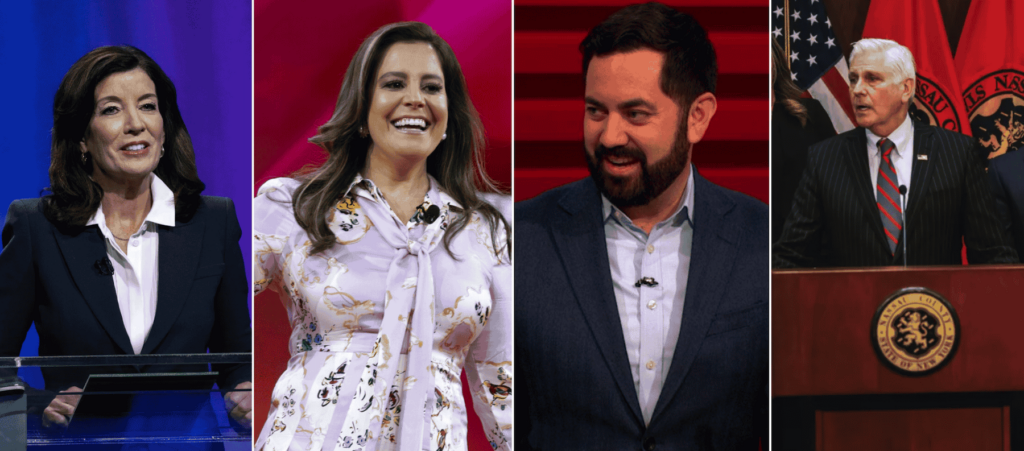
The race for New York governor may not officially kick off until 2026, but current Governor Kathy Hochul is already showing a commanding lead over potential Republican challengers, according to a new Siena College poll released in early summer 2025. The poll indicates that Hochul leads U.S. Rep. Elise Stefanik by 47% to 24%, U.S. Rep. Mike Lawler by 44% to 24%, and Nassau County Executive Bruce Blakeman by 44% to 19%. None of these Republican figures have formally announced their candidacy yet.
Among Democrats, Hochul appears to be the clear favorite, with 49% of the party’s support compared to 12% for Lt. Gov. Antonio Delgado and 10% for U.S. Rep. Ritchie Torres. On the Republican side, Stefanik is the frontrunner with 35%, outpacing Lawler at 18% and Blakeman at 7%. This early polling data provides an intriguing snapshot of the political landscape as both parties prepare for potential primaries.
Partisan Dynamics and Voter Sentiments
The Siena College Research Institute director, Don Levy, emphasized the fluid nature of political races, noting,
“Recognizing that 16 months in politics is many lifetimes away, a first look at how New York voters feel about potential gubernatorial matchups shows that partisanship wins out.”
Despite the significant leads, Levy pointed out that Hochul has not yet reached the critical 51% threshold against any of her potential opponents, and a notable portion of voters remain undecided.
Hochul’s current favorability rating stands at 42%-47%, a slight decline from 44%-46% in May. Her job approval rating is 50%-45%, showing minimal change from the previous month. Meanwhile, 37% of respondents are prepared to re-elect Hochul, while 55% express a desire for “someone else” to take office, figures that have remained stable since late May.
Republican Contenders and Their Strategies
Elise Stefanik, a prominent ally of former President Donald Trump, holds a 25%-32% favorability rating. Her recent activities, including increased media presence and commentary on statewide issues, suggest she is actively working to raise her profile across New York. Lawler, with a favorability rating of 22%-24%, and Blakeman, at 16%-17%, are also making efforts to establish themselves as viable candidates.
Stefanik’s political maneuvering has been evident since her nomination for Ambassador to the United Nations was withdrawn to maintain her congressional seat. Both she and Lawler have been vocal on issues beyond their congressional duties, signaling potential gubernatorial ambitions.
Democratic Perspectives and Internal Dynamics
On the Democratic front, Lt. Gov. Antonio Delgado and U.S. Rep. Ritchie Torres are trailing significantly behind Hochul. Delgado’s favorability rating is 24%-18%, while Torres stands at 22%-18%. Despite their lower numbers, the dynamics within the Democratic party could shift as the primary date approaches.
Levy noted,
“One year out from a potential primary, two in five Republicans don’t know who they’ll support among Stefanik, Lawler, and Blakeman, but Stefanik maintains an early lead, 17 points ahead of Lawler, who is 11 points ahead of Blakeman.”
This uncertainty underscores the evolving nature of the political race.
Legislative Developments: Medical Aid in Dying
Beyond the gubernatorial race, New Yorkers are also weighing in on significant legislative measures. The Medical Aid in Dying Act, which allows doctors to prescribe lethal medication to terminally ill patients, has garnered 54%-28% support among voters. The bill, having passed the Senate in early June, now awaits Governor Hochul’s signature to become law.
Levy commented on the bill’s reception, stating,
“While it doesn’t have the same level of support as several other less controversial bills that passed the Legislature at the end of session, voters support what some call medical aid in dying and others call physician-assisted suicide, 54%-28%.”
The measure enjoys widespread support across demographics, with at least 53% backing from voters in every region and age group.
As New York navigates these political and legislative landscapes, the coming months promise to be pivotal in shaping the state’s future. The unfolding dynamics within both major parties and the public’s stance on key issues will undoubtedly influence the direction of the 2026 gubernatorial race and beyond.






